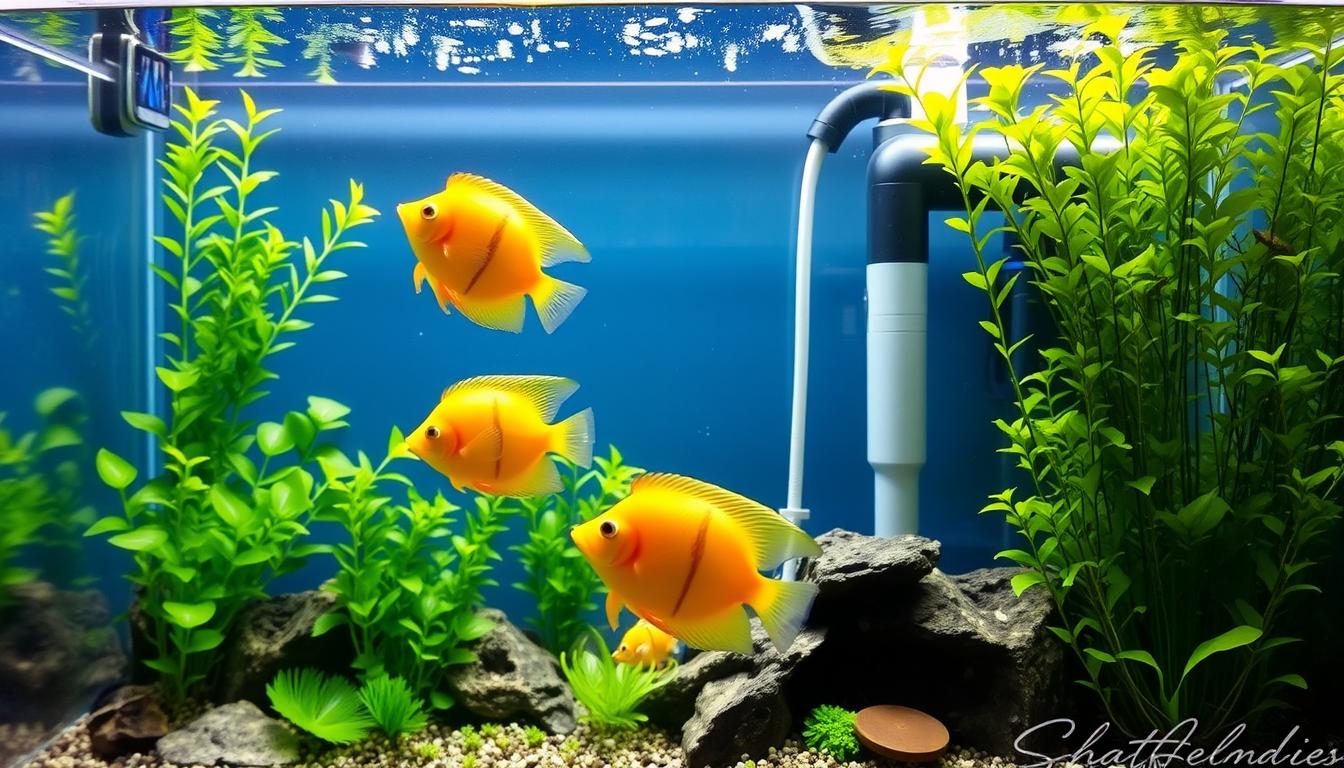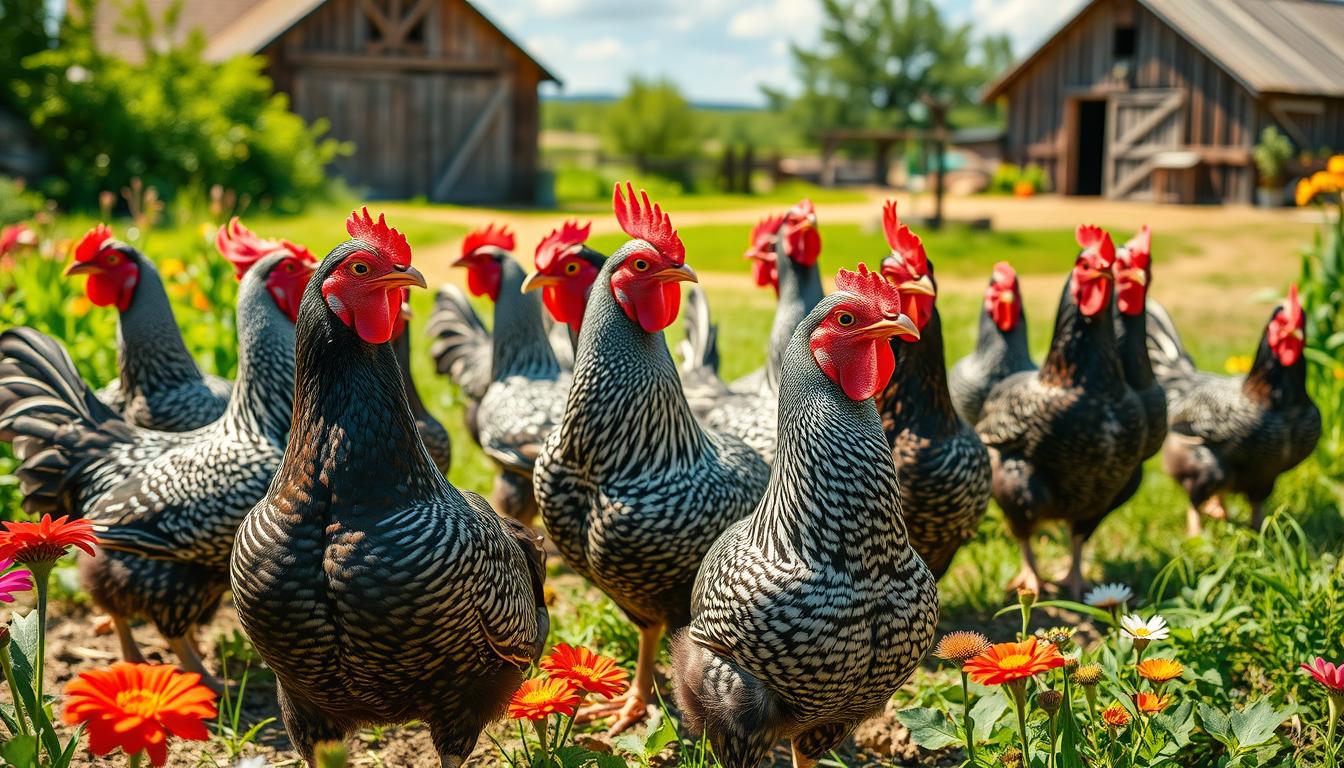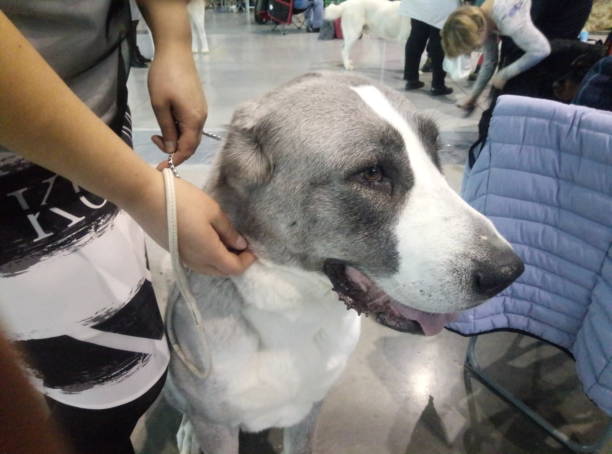Explore the Fascinating World of Leatherback Bearded Dragons: Complete Guide
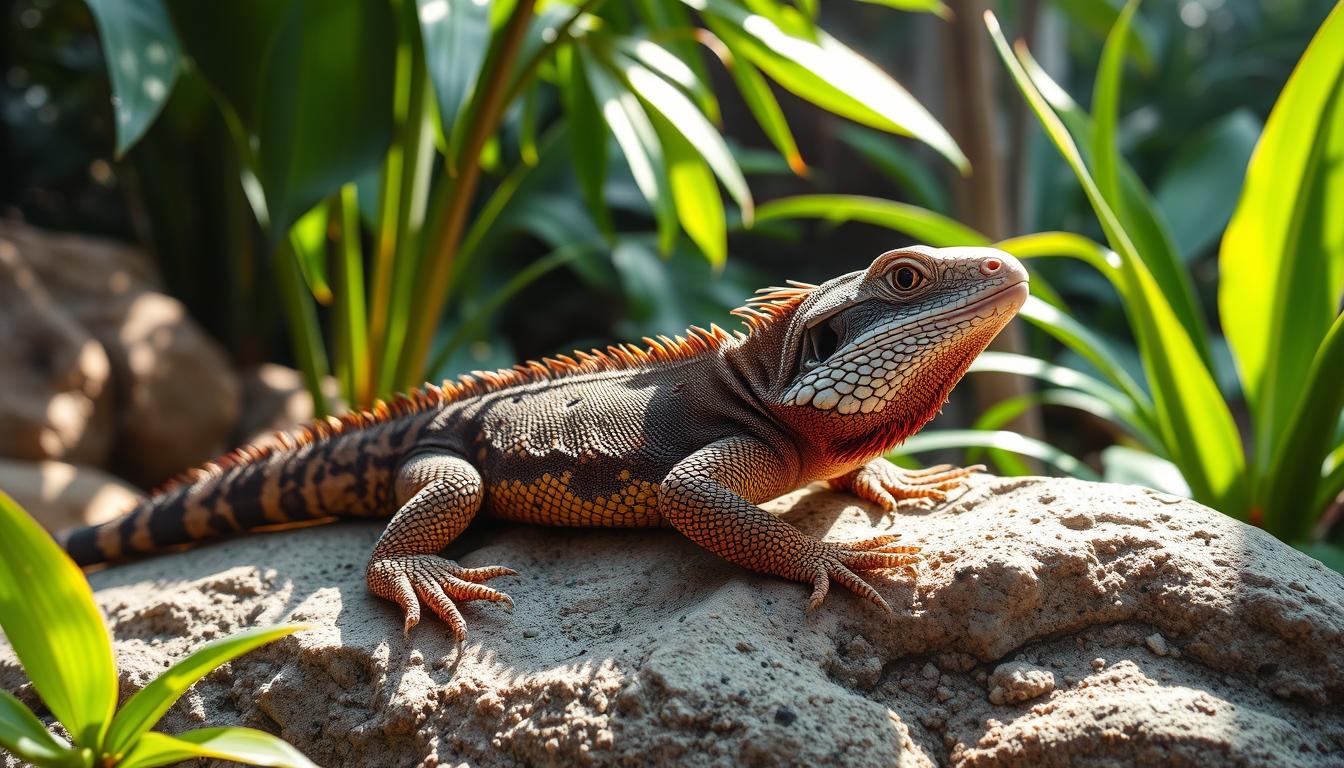
When you start learning about bearded dragons, you’ll find that leatherback bearded dragons stand out. They have smooth scales, unlike other morphs1. This unique trait comes from a special genetic mutation, making them popular pets. For more on these morphs, check out leatherback bearded dragon care guides.
Leatherback bearded dragons are loved for their calm nature and small size. Adults grow to 16 to 24 inches long1. Their smooth look is not just pretty but also a sign of their genetic uniqueness. For example, the hypo trait in bearded dragons leads to clear nails and brighter scales2.
Exploring leatherback bearded dragons, you’ll see they’re rarer than many other bearded dragons1. Their unique look and gentle nature make them a favorite among reptile lovers. Whether you’re new to pets or have experience, caring for a leatherback bearded dragon is rewarding and interesting.
Key Takeaways
- Leatherback bearded dragons are known for their smooth, leathery scales1.
- They are a popular choice among pet owners due to their gentle nature and relatively small size1.
- Their unique appearance is a result of a specific genetic mutation1.
- Leatherback bearded dragons are considered rarer than standard bearded dragons and other common morphs1.
- They can live for 10 to 15 years if properly cared for1.
- Leatherback bearded dragons might exhibit brighter colors compared to regular bearded dragons due to the different light refractions on their smoother skin1.
What Makes a Leatherback Bearded Dragon Unique
Exploring the world of bearded dragons, you might find the leatherback lizard. It’s a unique and fascinating creature. The leatherback scaleless dragon has a genetic mutation that makes its scales smaller, giving it a smoother look3. This trait sets leatherback bearded dragons apart from regular ones.
The leatherback trait is dominant in bearded dragon genetics. This means breeding a leatherback with a regular dragon can pass on the leatherback trait to their offspring4. About half of the hatchlings from breeding an Italian Leatherback with a regular dragon can be Leatherbacks4. This makes leatherback bearded dragons a favorite among breeders and enthusiasts.
Leatherback bearded dragons have smaller scales, making their backs feel smoother3. They also lack spikes on their back, which adds to their soft skin3. They come in various colors like red, orange, citrus, witblit, and zero3. Knowing these unique traits is key to caring for them well.
- They have a smoother appearance due to their smaller scales3
- They lack spikes on their back, contributing to their supple skin texture3
- They can come in a variety of colors, including red, orange, citrus, witblit, and zero3
- They are a result of a genetic mutation that affects the development of scales3
Understanding what makes leatherback bearded dragons unique helps us appreciate them. It also helps us care for them better, so they can thrive.
The Origins and Evolution of Leatherback Dragons
Exploring the world of leatherback bearded dragons means diving into their origins and evolution. These dragons, including leatherback morphs, come from Australia. They’ve adapted over time to their environment5. They belong to the genus Pogona, which includes eight lizard species known as bearded dragons5.
The bearded dragon morphs, like the leatherback, come from genetic variation and selective breeding. In the wild, they can grow up to 60 cm (24 in) long. Females can reach up to 51 cm (20 in)5. They have special traits, like brumation, a hibernation process, when temperatures are just right5.
For more on pet care and species evolution, check out pet care websites. They offer insights into different species and their traits. Studying leatherback bearded dragons and other bearded dragon morphs is fascinating6.
Knowing about the origins and evolution of leatherback bearded dragons is rewarding. It helps you appreciate these amazing animals and their unique traits. By understanding their history, you can give your leatherback bearded dragon the best life7.
Understanding Leatherback Bearded Dragon Genetics
If you’re thinking about getting a leatherback pet lizard, knowing about its genetics is key. Bearded dragon genetics can be tricky, but learning the basics helps a lot. The leatherback trait is special because it can mix with other genes to create new looks8.
The genetics behind the leatherback trait involve several genes, like hypo and translucent. The hypo gene is recessive, and so is the translucent gene8. Knowing this helps breeders plan and predict the leatherback trait in their lizards. For instance, they can use a Punnett square to guess the chance of a lizard having the leatherback trait.
Inheritance Patterns
The exact pattern of how the leatherback trait is passed down isn’t fully known. But, research shows it might involve more than one gene. For example, the Dunner gene, which is dominant, can affect a leatherback’s look9. This knowledge helps breeders choose the right parents for their lizards.
Common Genetic Combinations
There are a few common ways a bearded dragon can get the leatherback trait. These include mixing the leatherback and Dunner genes, or the leatherback and translucent genes10. Knowing these combinations helps breeders create unique and interesting lizards.
Some important terms to know in bearded dragon genetics are:
- Co-dominant: a gene that works with other genes
- Recessive: a gene that needs two copies to show up
- Dominant: a gene that shows up with just one copy
Understanding these terms and how they apply to leatherback bearded dragons is crucial. Whether you’re new to breeding or experienced, knowing genetics is key to success8.
Physical Features of Your Leatherback Pet Lizard
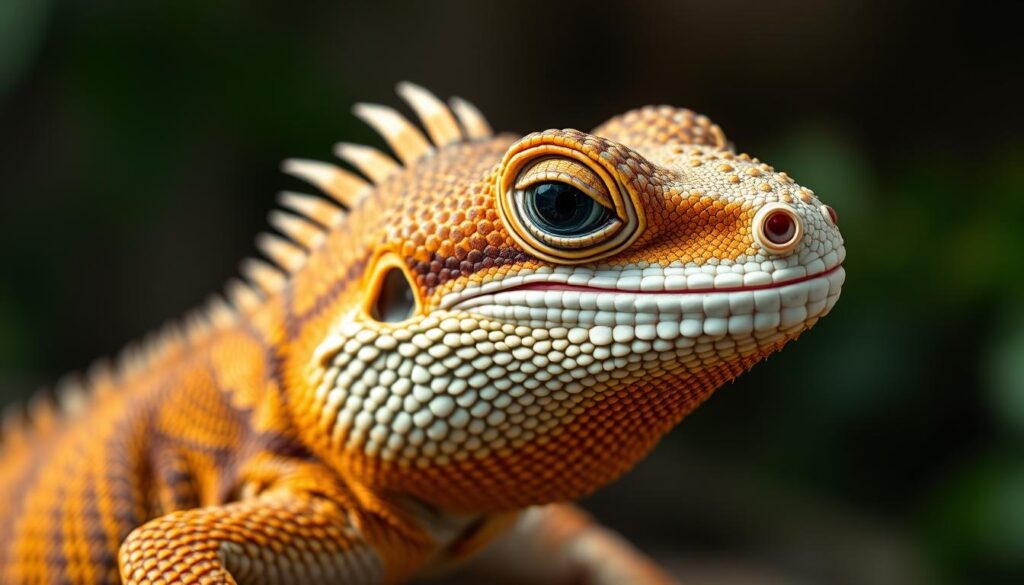
Your leatherback pet lizard has unique physical features. They have smooth, leathery skin and small scales11. These traits make them stand out and look different from other bearded dragons.
Bearded dragons, including leatherbacks, can grow up to 18-22 inches long12. They can live 7-12 years in captivity with the right care12. Males are bigger than females, with larger heads and darker ‘beards’12.
Leatherback lizards can change color a bit based on their mood13. They can also raise scales to look bigger when scared13. They have a special eye for thermoregulation and hormone control13. These features make them interesting and unique pets.
Leatherback dragons are very rare, with only a few born in captivity11. This makes them highly sought after by reptile lovers and collectors. If you want a leatherback lizard, research well and find a good breeder. This ensures you get a healthy and well-cared-for pet.
Essential Care Requirements for Leatherback Bearded Dragons
For the best care of your leatherback bearded dragon, mimic their natural habitat. Set up a suitable enclosure with a thermal gradient. The warm end should be at 100 F, and the cooler end at 75 F14. The ideal humidity is 30% to 50%14, and they need about 10-12 hours of UV light daily14.
Feeding your dragon a balanced diet is key. They should eat 70% insects and 30% vegetables, fruits, and treats14. Or, you can feed 70% leafy greens and 30% insects15. Offering a variety of foods ensures they get all the nutrients they need.
For more details on caring for leatherback bearded dragons, visit reptifiles.com. By following these guidelines and creating a suitable environment, you can help your dragon thrive. This way, they can live a happy and healthy life.
Housing and Environment Setup
Juvenile bearded dragons need a 20-gallon habitat, while adults require 40+ gallons14. Or, a tank of at least 4 x 2 x 2 feet is recommended15. Make sure they have at least two hiding spots. The temperature should range from 80 degrees Fahrenheit for the cool side to 95–104 degrees Fahrenheit for the basking area15.
Health Considerations Specific to Leatherback Morphs
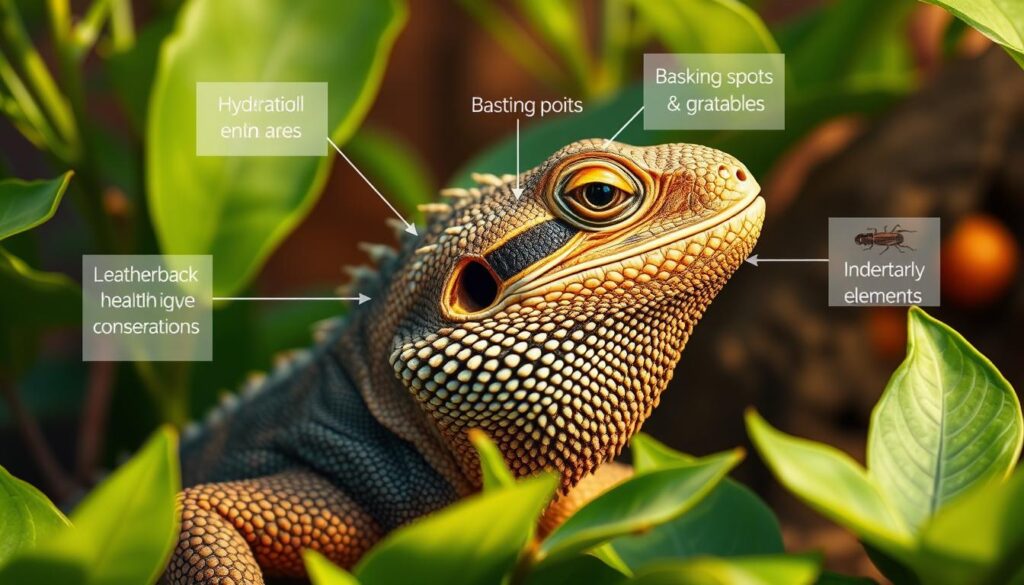
As a leatherback bearded dragon owner, knowing about their health is key. These dragons can get skin problems because of their scales16. But, their skin isn’t more delicate than others16. Keeping their environment right is important. This means a warm spot of 38–42°C and a cooler area of 22–26°C17.
Feeding them right is also vital. They need lots of live food and greens, with at least 30% greens for adults17. Watch out for common problems like metabolic bone disease and respiratory infections18. Regular vet visits and a clean home can help avoid these.
Here are some health tips for leatherback bearded dragon owners:
- Provide a naturalistic environment with a thermal gradient
- Use the right substrates to avoid impactions
- Feed a balanced diet with live food and greens
- Limit handling to 10-15 minutes to avoid stress
By following these tips and knowing about leatherback bearded dragons’ health, you can keep your pet happy and healthy.
| Health Issue | Description |
|---|---|
| Metabolic Bone Disease | A common health issue in captive reptiles, caused by a lack of calcium and vitamin D3 |
| Respiratory Infections | Bacterial or fungal infections that can cause respiratory problems in bearded dragons |
Behavioral Traits and Temperament
As a leatherback pet lizard owner, it’s key to know your pet’s behavior. This helps in building a strong bond and ensuring proper care. Leatherback bearded dragons are known to be tame and fun, enjoying interaction with their owners19. They are also friendly and can be handled gently and safely.
Training and handling are vital for leatherback bearded dragon care. With patience and consistency, you can teach your pet to follow commands and interact positively. It’s also crucial to understand their basking, eating, and sleeping patterns to ensure they are healthy and happy. For more info on bearded dragon behavior, check out this resource on leatherback bearded dragon behavior.
When interacting with your leatherback pet lizard, be gentle, move slowly, and avoid sudden movements. By following these tips and understanding your pet’s unique traits, you can create a rewarding relationship19.
Common Behavioral Patterns
- Basking: Bearded dragons love to bask in the sun or under a heat lamp to regulate their body temperature.
- Eating: A balanced diet that includes a variety of vegetables, fruits, and proteins is essential for your pet’s health and well-being.
- Sleeping: Bearded dragons typically sleep for 10-12 hours a day, and it’s essential to provide a comfortable and quiet environment for them to rest.
By understanding and responding to these behavioral patterns, you can provide the best care for your leatherback pet lizard. This way, you can enjoy a happy and healthy relationship with your pet19.
Creating the Perfect Habitat for Your Leatherback Beardie
Creating a good leatherback bearded dragon habitat involves several key points. Your pet needs a well-ventilated, spacious place with the right lighting and temperature. Experts suggest a 48”x24”x18” enclosure for your dragon’s health and happiness20.
This size allows your dragon to move and act naturally. It’s important for their well-being.
The type of substrate is also critical. Choose a rough surface tile for easy cleaning and safety20. Consider a heat pad or emitter for the right temperatures at night20.
For leatherback lizard care, letting them bask in the sun is key. It gives them UVA and UVB, which they need21. A basking spot of 95-100 degrees Fahrenheit is best for all ages21.
For more tips on setting up your dragon’s habitat, check out dragonsdiet.com or petpawza.com. They offer great advice on leatherback bearded dragon habitat and leatherback lizard care202221.
Common Myths About Leatherback Bearded Dragons
Thinking about getting a leatherback bearded dragon? You might have heard some myths. One myth is they are easy pets, but that’s not right23. They actually need a lot of care to be happy and healthy.
Another myth is they can live in small tanks. But, they really need a big space to move and play23. A larger tank is key for their well-being.
Some think leatherback bearded dragons are mean and not good pets. But, this isn’t always true23. They can be territorial and might bite if scared, but many are gentle and loving.
It’s also important to know they have special food needs. A varied diet is crucial for their health23
By learning the truth, you can decide if a leatherback bearded dragon is right for you. Always do your homework and give them the care they deserve24.
Cost and Commitment of Ownership
Thinking about getting a leatherback bearded dragon? It’s key to know the costs and what it takes to care for them. The price can change based on things like the lizard’s morph, color, age, and how rare it is25. On average, a regular bearded dragon might cost between $30 and $60. But, a leatherback bearded dragon can be pricier because of its special look25.
There are also ongoing costs like food, lighting, and vet visits. The price for enclosures, heaters, and UV lights can be from $100 to over $1,000, depending on size and quality25. Don’t forget about extra stuff like hygrometers, thermometers, and thermostats, which can cost between $15 and $15025.
Initial Setup Expenses
The first costs for a leatherback bearded dragon are big, but they’re important for your pet’s health and happiness. Some key expenses include:
- Enclosure: $100-$1,00025
- Heating and UV lighting: $15-$15025
- Food and supplements: $20-$50 per month26
- Veterinary care: $50-$100 per visit26
Ongoing Care Costs
There are also ongoing costs like food, lighting, and vet visits. These costs can change based on your lizard’s size, age, and the quality of care26. It’s important to include these costs in your budget and think about your pet’s long-term care26.
Knowing the costs and commitment needed for a leatherback bearded dragon helps you decide if it’s the right pet for you. With the right care, they can be loving and wonderful companions. The cost of their care is worth it for their health and happiness25.
Conclusion: Is a Leatherback Bearded Dragon Right for You
Leatherback bearded dragons27 are truly unique and fascinating pets. They have distinctive features, captivating personalities, and special care needs. If you’re ready to provide the right environment, diet, and attention, a leatherback beardie could be a wonderful companion28.
Before making a decision, think about your lifestyle and experience. Leatherback bearded dragons need a big habitat, precise temperature and lighting, a varied diet of insects and greens27, and regular interaction and handling29. If you can offer this level of care, owning a leatherback dragon can be incredibly rewarding.
The choice is yours, but with the right preparation and commitment, a leatherback bearded dragon can become a lifelong friend. Look into your options, talk to experts, and make a choice that fits your life and preferences272829.
FAQ
What makes leatherback bearded dragons unique?
How does the leatherback mutation affect the physical appearance of these dragons?
Where do leatherback bearded dragons come from?
How is the leatherback trait inherited in bearded dragons?
What are the distinctive physical features of a leatherback bearded dragon?
What are the specific care requirements for leatherback bearded dragons?
Are there any health concerns specific to leatherback bearded dragons?
How do leatherback bearded dragons typically behave, and what should I know about handling them?
What essential equipment and habitat setup do I need for a leatherback bearded dragon?
What are some common myths or misconceptions about leatherback bearded dragons?
What are the financial and time commitments involved in owning a leatherback bearded dragon?
Source Links
- https://www.myseniorpaws.com/leatherback-bearded-dragon/ – Leatherback Bearded Dragon 101: Origin, Care & Tips
- https://www.herebdragons.com/bearded-dragon-mutations – A Guide to Bearded Dragon Mutations and Genetic Traits — HereBDragons.com
- https://www.carolinaclassicdragons.com/bearded-dragons/leatherback-bearded-dragons – Leatherback Bearded Dragons
- https://www.dachiubeardeddragons.com/dragoncare/leatherback.html – Information on Leatherback / Silkback Bearded Dragons
- https://en.wikipedia.org/wiki/Pogona – Pogona
- https://www.herebdragons.com/chimera-bearded-dragon – Chimera Bearded Dragon — HereBDragons.com
- https://digitalcommons.murraystate.edu/cgi/viewcontent.cgi?article=1070&context=honorstheses – Intelligence of Bearded Dragons
- https://www.mikesbeardeds.com/mutation-guide – Mutation Guide | Mikes Beardeds
- https://www.bourboncityexotics.com/bceblog/genetics-and-phenotypes – Genetics and Phenotypes — Bourbon City Exotics
- https://www.reptileforums.co.uk/threads/beardie-hets-and-hypos-and-other-morphs-can-anyone-explain-it-to-me.1019231/ – Beardie Hets and Hypo’s and other Morphs can anyone…
- https://www.reptileforums.co.uk/threads/new-morph-of-beardie.34331/ – New morph of beardie
- https://vcahospitals.com/know-your-pet/bearded-dragons-owning – Owning Bearded Dragons | VCA Animal Hospitals
- https://en.wikipedia.org/wiki/Central_bearded_dragon – Central bearded dragon
- https://www.petmd.com/reptile/bearded-dragon-care-sheet – Bearded Dragon Care Sheet
- https://pangovet.com/pet-breeds/bearded-dragons/leatherback-bearded-dragon/ – Leatherback Bearded Dragon: Facts, Info, Pictures & Care Guide | PangoVet
- https://community.morphmarket.com/t/morph-issues-bearded-dragons/29242 – Morph Issues [Bearded Dragons]
- https://www.rspca.org.uk/adviceandwelfare/pets/other/beardeddragon – How To Care For Your Bearded Dragon | RSPCA – RSPCA – rspca.org.uk
- https://www.veterinarypracticenews.com/a-practitioners-guide-to-bearded-dragons/ – A practitioner’s guide to bearded dragons
- https://www.thesprucepets.com/bearded-dragon-morphs-4173672 – What Morphs Do Bearded Dragons Come In?
- https://atomiclizardranch.net/information-on-bearded-dragon-enclosure-set-ups/ – INFORMATION ON BEARDED DRAGON ENCLOSURE & SET-UPS | Atomic Lizard Ranch
- https://www.cbreptile.com/bearded-dragon-habitat/?srsltid=AfmBOoplEly_dUvrsjB1MyVwdOnl4SxrH-E5sbAMyNEUL4vvA9AavSND – Bearded Dragon habitat
- https://www.reptileforums.co.uk/threads/bearded-dragon-detailed-care-guide.833790/ – Bearded Dragon (Detailed Care Guide)
- https://avoicefromthefield.wordpress.com/2018/08/03/bearded-dragons-top-5-myths-and-misconceptions/ – Bearded Dragons: Top 5 Myths and Misconceptions
- https://dragonsdiet.com/blogs/dragon-care/29-bearded-dragon-fun-facts – Bearded Dragon Fun Facts: 29 Cool Things You Probably Didn’t Know abou
- https://beardeddragonsworld.com/bearded-dragons-cost/ – How Much Do Bearded Dragons Cost? Budgeting the Real Costs
- https://www.fireandicedragons.com/pricing.cfm – Fire and Ice Dragons
- https://aminoapps.com/c/reptiles/page/item/bearded-dragon/Yjo3_ornsXI01ebx14de1mn21j5KqQMjbzq – Bearded Dragon | Wiki | Reptiles Amino
- https://vetcarehosp.com/2024/09/15/fascinating-facts-about-bearded-dragons/ – Fascinating Facts About Bearded Dragons | V.E.T. Care Hospital
- https://exo-terra.com/explore/care-guides/lizards/pogona-vitticeps/ – Bearded Dragon

